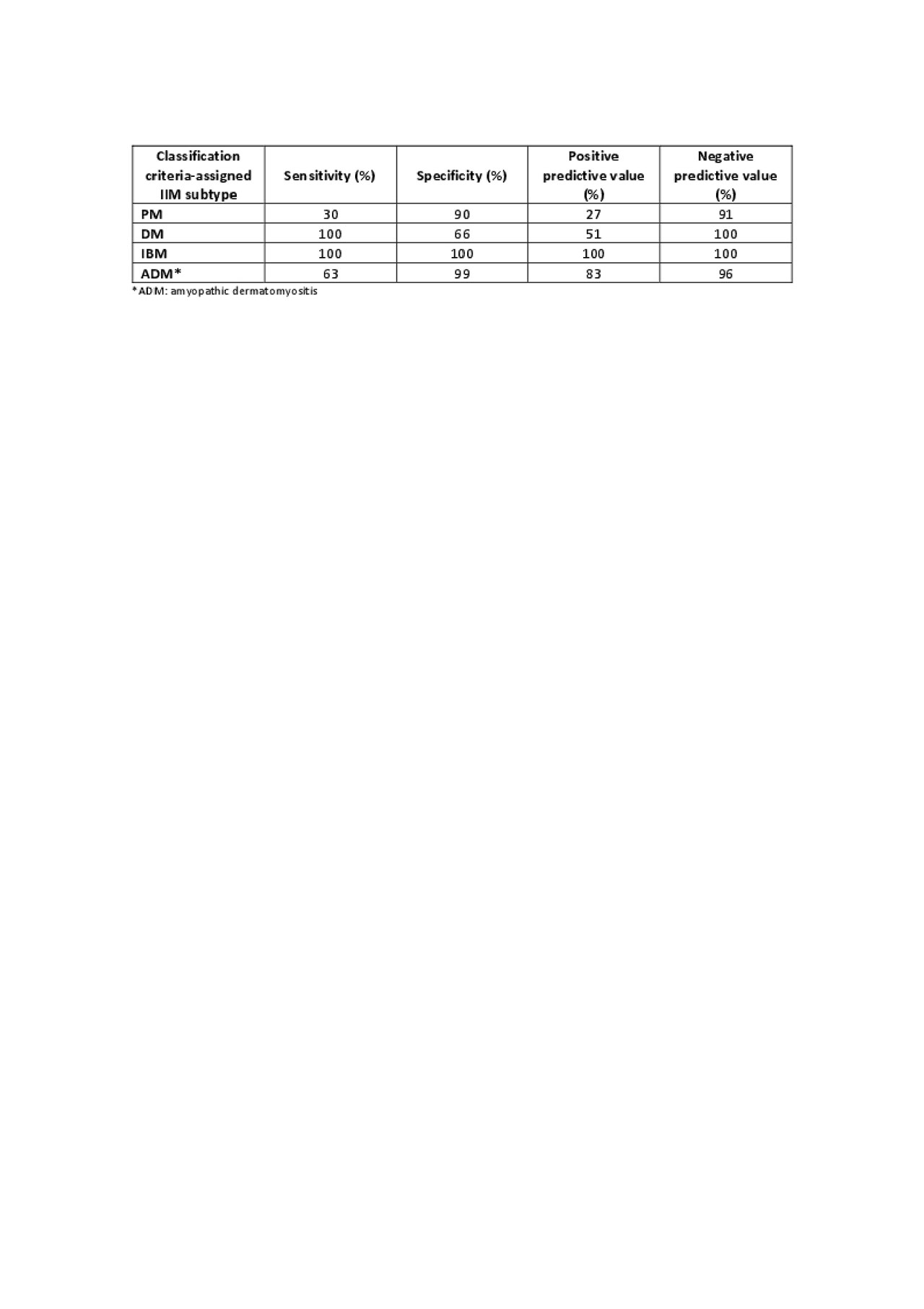Session Information
Session Type: Poster Session (Sunday)
Session Time: 9:00AM-11:00AM
Background/Purpose: Idiopathic Inflammatory Myopathies (IIM) are rare and heterogenous diseases, remaining a clinical challenge and persisting with high morbidity and mortality. The lack of consensus in their classification has added difficulties to the development of novel and effective therapeutic strategies, precluding clinical trials with significant and reproductible results. The recently published EULAR/ACR criteria were developed to overcome the fragilities of the previous most used criteria.
The objective of this study is to evaluate the performance of the new classification criteria in a real-life cohort of adult patients with IIM.
Methods: Retrospective review of the cohort of adult patients followed in a dedicated unit of a tertiary hospital, between January 2008 and December 2018. Clinical, serological and histological data were collected. EULAR/ACR classification criteria were applied to each individual patient using the web calculator. Clinical diagnosis was obtained from 2 experts, for each case, and all the patients with a definitive IIM were included in the analysis. Sensibility, sensitivity, positive and negative predictive values were calculated for each of the classification subtypes.
Results: Ninety-two patients were included, 79 women (85.9%) and 15 men, with a medium age at diagnosis of 47 years-old and a medium follow-up period of 12 years. Muscle biopsy results were available in 43.5% of cases, but only 62.5% presented parameters compatible with the criteria specifications. EULAR/ACR classification criteria resulted in a definitive diagnosis of IIM in 52/92 cases (56.5%) and a probable diagnosis in 25/92 cases (27.2%), with the remaining 15 cases (16.3%) having a probability of IIM of less than 50%. Regarding IIM assigned subtypes, we found overall high negative predictive values and good specificity (table 1). Sensitivity was heterogenous among the subtypes: very high for Dermatomyositis (DM) and Inclusion-Body Myositis (IBM) and low for Polymyositis (PM). The most strinking differences between expert clinical diagnosis and classification criteria-assigned subtypes were in PM, reducing drastically the sensitivity. Overlap myositis, anti-synthetase syndrome and paraneoplastic myositis were the cases that contributed the most for the group that did not score enough for a diagnosis of IIM using the criteria, as well as for the differences between clinical diagnosis and classification results in PM and DM.
Conclusion: EULAR/ACR criteria applied to this cohort presented high specificity but only moderate sensitivity, particularly in some subtypes, as PM. A number of factors may be contributive, namely the absence of pulmonar involvement in the clinical variables and the stringicity of cutaneous involvement parameters and histological features. The most recent developments in the pathogenesis of IIM, particularly regarding myositis-specific antibodies, could be of interest to be added to the classification in order to include those patients with an atypical clinical presentation.
To cite this abstract in AMA style:
Campar A, Vasconcelos C. Performance of EULAR/ACR Classification Criteria for Idiopathic Inflammatory Myopathies in a Real-life Cohort of Adult Patients [abstract]. Arthritis Rheumatol. 2019; 71 (suppl 10). https://acrabstracts.org/abstract/performance-of-eular-acr-classification-criteria-for-idiopathic-inflammatory-myopathies-in-a-real-life-cohort-of-adult-patients/. Accessed .« Back to 2019 ACR/ARP Annual Meeting
ACR Meeting Abstracts - https://acrabstracts.org/abstract/performance-of-eular-acr-classification-criteria-for-idiopathic-inflammatory-myopathies-in-a-real-life-cohort-of-adult-patients/

